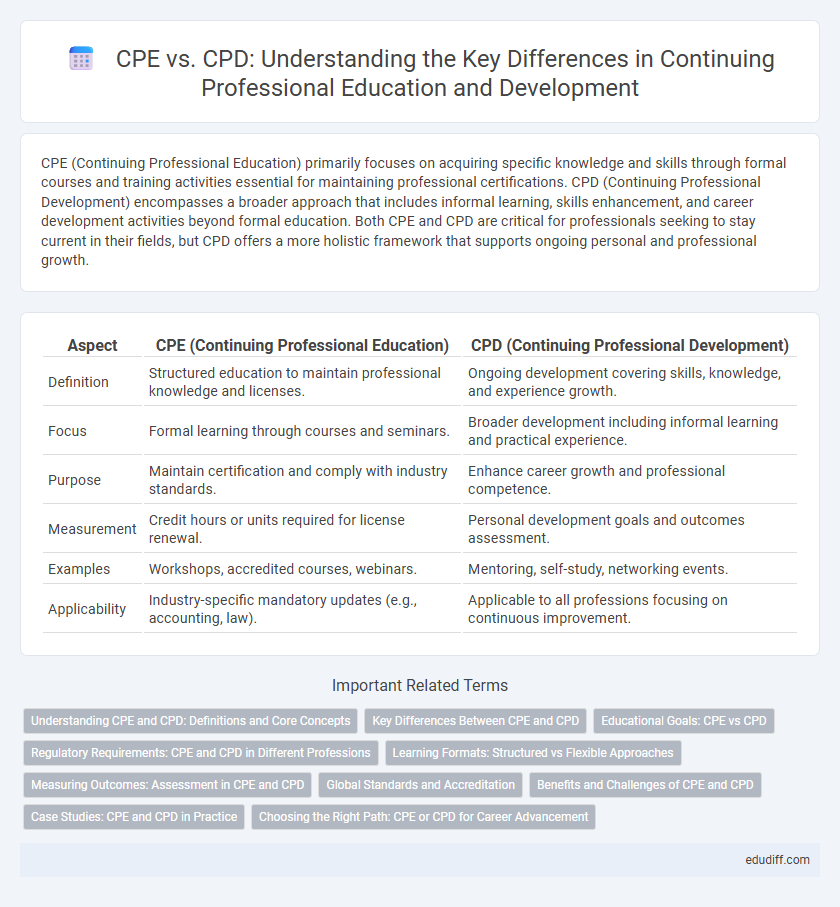CPE (Continuing Professional Education) primarily focuses on acquiring specific knowledge and skills through formal courses and training activities essential for maintaining professional certifications. CPD (Continuing Professional Development) encompasses a broader approach that includes informal learning, skills enhancement, and career development activities beyond formal education. Both CPE and CPD are critical for professionals seeking to stay current in their fields, but CPD offers a more holistic framework that supports ongoing personal and professional growth.
Table of Comparison
| Aspect | CPE (Continuing Professional Education) | CPD (Continuing Professional Development) |
|---|---|---|
| Definition | Structured education to maintain professional knowledge and licenses. | Ongoing development covering skills, knowledge, and experience growth. |
| Focus | Formal learning through courses and seminars. | Broader development including informal learning and practical experience. |
| Purpose | Maintain certification and comply with industry standards. | Enhance career growth and professional competence. |
| Measurement | Credit hours or units required for license renewal. | Personal development goals and outcomes assessment. |
| Examples | Workshops, accredited courses, webinars. | Mentoring, self-study, networking events. |
| Applicability | Industry-specific mandatory updates (e.g., accounting, law). | Applicable to all professions focusing on continuous improvement. |
Understanding CPE and CPD: Definitions and Core Concepts
Continuing Professional Education (CPE) primarily focuses on formal learning activities designed to maintain and enhance professional knowledge and skills, often involving structured courses and seminars. Continuing Professional Development (CPD) encompasses a broader approach, integrating learning from various experiences including informal education, self-directed learning, and reflective practice to foster continuous growth. Both CPE and CPD play crucial roles in career advancement, with CPE emphasizing compliance and certification requirements, while CPD supports holistic professional competence and lifelong learning.
Key Differences Between CPE and CPD
CPE (Continuing Professional Education) primarily emphasizes formal education and structured learning activities to maintain specific professional licenses or certifications, often required by regulatory bodies in fields such as accounting and finance. CPD (Continuing Professional Development) encompasses a broader spectrum, including informal learning, skill development, and career growth initiatives beyond mandatory coursework. The key differences lie in CPE's focus on compliance and specific knowledge updates versus CPD's aim to enhance overall professional competence and adaptability through diverse learning experiences.
Educational Goals: CPE vs CPD
CPE (Continuing Professional Education) primarily targets acquiring specific knowledge and technical skills needed to maintain professional competence, often through structured courses and exams, with quantifiable credit hours. CPD (Continuing Professional Development) encompasses a broader scope, focusing on lifelong learning that includes soft skills, reflective practice, and personal growth alongside formal education to achieve comprehensive career development. Educational goals within CPE are measurable and compliance-driven, whereas CPD emphasizes continuous improvement and adaptability to evolving industry demands.
Regulatory Requirements: CPE and CPD in Different Professions
Regulatory requirements for CPE and CPD vary significantly across professions, with CPE often mandated for fields like accounting, law, and healthcare to maintain licensure and certifications. CPD encompasses a broader scope of professional growth and is frequently required in education, engineering, and social work, emphasizing skill enhancement beyond technical knowledge. Compliance with these regulatory frameworks ensures professionals meet industry standards and stay updated with evolving practices.
Learning Formats: Structured vs Flexible Approaches
CPE emphasizes structured learning formats with formal coursework, exams, and standardized content to ensure compliance and certification requirements. CPD incorporates flexible approaches, including informal learning, on-the-job experiences, and self-directed study, supporting personalized career growth and skill development. Both formats contribute to lifelong learning but cater to different professional needs and regulatory demands.
Measuring Outcomes: Assessment in CPE and CPD
Measuring outcomes in CPE focuses on assessing knowledge retention and skill acquisition through exams and practical evaluations to ensure compliance with professional standards. CPD emphasizes broader competency development by incorporating reflective practice, self-assessment, and real-world application to demonstrate ongoing growth and adaptability. Both approaches integrate evaluation methods but differ in scope, with CPE targeting specific learning outcomes and CPD promoting holistic professional advancement.
Global Standards and Accreditation
CPE (Continuing Professional Education) and CPD (Continuing Professional Development) differ primarily in scope and global standards alignment; CPE often emphasizes mandatory credit hours tied to certification maintenance, while CPD incorporates a broader, competency-based approach fostering lifelong learning and skills enhancement. International accreditation bodies like AACSB, CPA Australia, and IFAC promote CPD frameworks that integrate personal development plans, reflective learning, and tailored professional growth, ensuring consistency and relevance across diverse industries. Adherence to these global standards enhances practitioner credibility, supports regulatory compliance, and facilitates cross-border professional recognition.
Benefits and Challenges of CPE and CPD
CPE (Continuing Professional Education) offers structured learning with defined courses and credits, enhancing specific technical skills and ensuring compliance with professional licensing requirements. CPD (Continuing Professional Development) provides a broader approach, fostering personal growth, leadership, and career advancement through diverse learning activities and reflective practices. Challenges of CPE include a narrow focus and potential rigidity, while CPD may lack standardized measurement and require greater self-motivation to achieve meaningful outcomes.
Case Studies: CPE and CPD in Practice
Case studies demonstrate that CPE emphasizes acquiring specific skills and knowledge, enhancing technical proficiency through targeted courses and certifications. CPD focuses on holistic professional growth, integrating experiential learning, reflective practice, and broader competencies such as leadership and communication. Organizations leveraging both CPE and CPD frameworks report improved employee performance, adaptability, and sustained career advancement.
Choosing the Right Path: CPE or CPD for Career Advancement
Selecting between Continuing Professional Education (CPE) and Continuing Professional Development (CPD) hinges on career goals and industry requirements. CPE emphasizes acquiring specific technical skills and certifications essential for professions like accounting and finance, aligning directly with compliance and licensure maintenance. CPD offers a broader approach, fostering personal growth, leadership abilities, and adapting to industry trends, thus supporting long-term career advancement beyond mandatory education mandates.
CPE (Continuing Professional Education) vs CPD (Continuing Professional Development) Infographic

 edudiff.com
edudiff.com